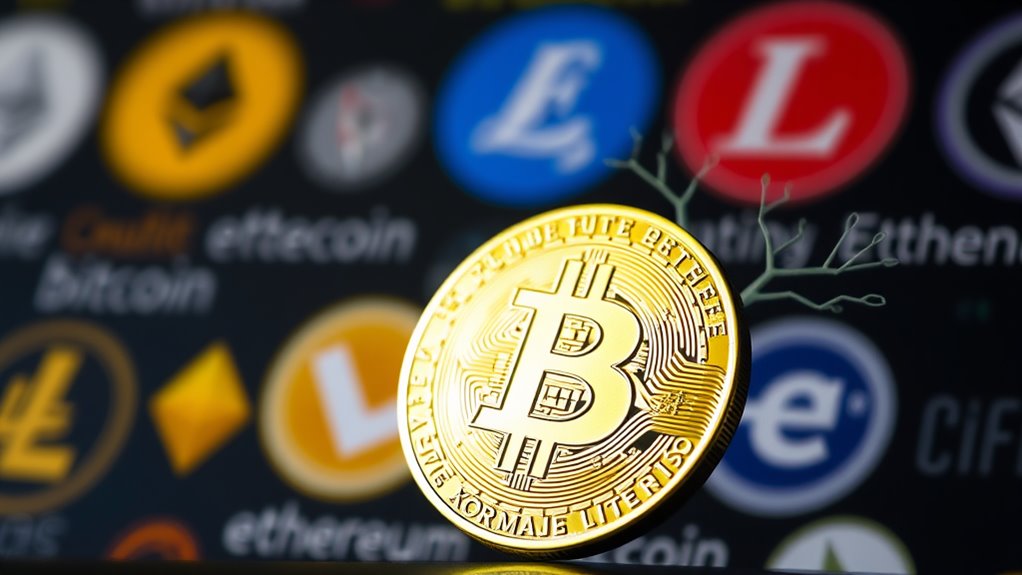
Bitcoin Forks: What Are They and How Do They Work?
Bitcoin forks occur when the blockchain splits into separate chains with different rules. Hard forks create entirely new cryptocurrencies (like Bitcoin Cash) that are incompatible with the original, while soft forks (like SegWit) implement backward-compatible updates. These splits result from technical disagreements about Bitcoin's future, requiring miners and nodes to signal support through block headers. Forks cause market volatility and demand user attention to wallet updates and exchange policies. The mechanisms behind these changes reveal Bitcoin's evolving consensus landscape.
Key Takeaways
- Bitcoin forks are blockchain splits creating two separate chains with different rules, occurring as either hard forks or soft forks.
- Hard forks create incompatible blockchains requiring software upgrades, often resulting in new cryptocurrencies like Bitcoin Cash.
- Soft forks maintain backward compatibility, allowing old and new software to coexist while introducing improvements like SegWit.
- Forks implement changes to consensus protocols and mining algorithms, requiring community discussion and activation signaling.
- During fork events, users must update wallet software, verify exchange policies, and monitor market conditions to protect assets.
Understanding Bitcoin Forks: Hard vs. Soft Forks

As cryptocurrencies continue to evolve, Bitcoin forks represent critical moments in the blockchain's development cycle. These forks occur when the Bitcoin blockchain splits into two separate chains with different rules, resulting in either minor modifications or major changes to the network.
Bitcoin forks come in two primary varieties: hard forks and soft forks. Hard forks create incompatible blockchains, requiring all participants to upgrade their software and often resulting in new cryptocurrencies like Bitcoin Cash. They typically generate controversy due to community fragmentation.
Bitcoin's hard forks drive innovation but split communities, while soft forks evolve the network without breaking compatibility.
In contrast, soft forks maintain backward compatibility, allowing old and new software versions to coexist on the network. These less controversial updates, such as SegWit and Taproot, implement security improvements without splitting the blockchain.
Both types of forks reflect the challenges of reaching consensus in decentralized networks. Understanding these forks requires knowledge of how blockchain technology functions as a distributed ledger that maintains the security and integrity of Bitcoin transactions.
The Historical Development of Bitcoin Forks

While Bitcoin established itself as the original cryptocurrency, its evolutionary path has been marked by numerous forks that shaped its technological landscape.
Early notable forks like Bitcoin XT (2014) attempted to increase block size from 1MB to 8MB but failed to gain lasting adoption.
Mid-2016 saw Bitcoin Classic proposing a moderate 2MB increase, while Bitcoin Unlimited allowed miners to decide block sizes up to 16MB. Neither achieved widespread acceptance.
The most significant developments occurred in 2017 with Bitcoin Cash increasing block size to 32MB and Bitcoin Gold modifying mining algorithms to favor GPU miners over specialized ASICs.
Soft forks like SegWit (2017) introduced improvements without creating new cryptocurrencies, enhancing transaction efficiency while maintaining backward compatibility.
Later, Taproot built on this foundation with privacy and efficiency upgrades.
Technical Mechanisms Behind Fork Implementation

The implementation of Bitcoin forks requires specific technical changes to the network's consensus protocol, which establishes the rules for transaction validation and block creation.
These alterations often necessitate adjustments to the mining difficulty algorithm, ensuring the newly forked chain can maintain consistent block times despite potential fluctuations in hash power.
Both soft and hard forks demand careful calibration of these technical mechanisms to prevent network instability, with developers typically scheduling changes at predetermined block heights to allow for proper preparation by all network participants.
Consensus Protocol Changes
Technical mechanisms underpinning Bitcoin forks involve complex processes designed to modify the network's consensus rules.
These rules determine how transactions and blocks are validated across the decentralized system, requiring broad agreement among participants to implement changes.
When developers propose modifications to Bitcoin's protocol, they must navigate various activation methods.
Soft forks maintain backward compatibility, allowing new and old software versions to coexist on the same blockchain through majority node signaling.
Hard forks, conversely, create entirely new blockchains with modified rules that break compatibility with the original network.
The implementation process typically follows a pattern of proposal, community discussion, and activation signaling.
Without central authority, economic nodes play a significant role in validating and implementing these changes, highlighting the coordination challenges inherent in decentralized governance.
Mining Difficulty Adjustments
Beyond consensus protocol changes, mining difficulty adjustments represent another fundamental technical element that impacts Bitcoin forks.
The Bitcoin network automatically adjusts mining difficulty every 2,016 blocks (approximately every two weeks) to maintain a consistent 10-minute average block time.
When a fork occurs, the resulting chains must manage their own difficulty adjustments independently. This becomes particularly vital as mining power redistributes between the original chain and the fork.
While forks don't directly alter the difficulty adjustment mechanism itself, they create separate networks that must establish equilibrium with their available hashrate.
If a fork attracts markedly less mining power than the original chain, it may initially struggle with slower block times until its first difficulty adjustment occurs.
This technical challenge often requires careful planning by fork developers to guarantee network stability during the changeover period.
Major Bitcoin Hard Forks and Their Features

Bitcoin Cash emerged as a pivotal hard fork, implementing significant technical differences including an increased block size of up to 32 megabytes to address scalability concerns.
This modification allows Bitcoin Cash to process more transactions per block than the original Bitcoin, making it potentially more efficient for everyday payment applications.
Bitcoin SV (Satoshi Vision), a subsequent fork of Bitcoin Cash, embraces a design philosophy centered on restoring Bitcoin to its creator's original protocol, with even larger block sizes and an emphasis on becoming a global payment system rather than just a store of value.
Bitcoin Cash Technical Differences
The primary differences between Bitcoin Cash and its parent cryptocurrency revolve around fundamental technical modifications designed to enhance scalability and everyday usability. Created as a hard fork in August 2017, Bitcoin Cash considerably increased the block size from Bitcoin's 1MB to eventually 32MB, enabling faster transaction processing.
| Feature | Bitcoin | Bitcoin Cash |
|---|---|---|
| Block Size | 1 MB | 32 MB |
| Transactions Per Second | 3-7 TPS | 100+ TPS |
| Transaction Fees | Often high | Less than $0.01 |
| Confirmation Time | Up to 60+ minutes | Usually within 30 minutes |
| Smart Contract Support | Limited native capacity | Built-in with Cashscript |
This technical architecture makes Bitcoin Cash more suitable for everyday transactions and micropayments while supporting advanced functionalities like smart contracts and DeFi services through its enhanced scripting capabilities. Unlike Ethereum which primarily focuses on smart contracts and programmable applications, Bitcoin Cash prioritizes its function as a peer-to-peer electronic cash system with improved transaction throughput.
Bitcoin SV Design Philosophy
Created in November 2018 as a contentious hard fork of Bitcoin Cash, Bitcoin SV (Satoshi Vision) embodies a design philosophy centered on adhering to what its proponents claim was Satoshi Nakamoto's original vision for Bitcoin.
BSV focuses primarily on scalability through increased block sizes rather than alternative solutions like SegWit. Starting with 128MB blocks that later expanded to 2GB after the Quasar upgrade, BSV aims to enable high-volume, low-cost transactions. This approach contrasts with Bitcoin's smaller block strategy.
BSV presents itself as regulation-friendly, seeking mainstream adoption while supporting smart contract functionality. Its philosophy emphasizes on-chain scaling exclusively through block size increases, with miners able to adjust block parameters based on network consensus.
However, this approach has raised concerns about potential centralization risks, as larger blocks require more powerful nodes to process. Unlike Bitcoin, which has gained recognition as a store of value in the global financial landscape, BSV has struggled to achieve similar mainstream adoption.
Soft Fork Innovations That Shaped Bitcoin

Evolving through strategic software updates, Bitcoin's development history showcases the power of soft forks in enhancing network capabilities without disrupting its fundamental structure.
These backwards-compatible upgrades have repeatedly strengthened Bitcoin's foundation while maintaining network unity. Notable implementations include P2SH (2012), which enabled multi-signature transactions, and Block v2, which added block height to coinbase transactions.
BIP 66 addressed transaction malleability through stricter signature rules, while SegWit (2017) greatly improved scalability and security. Unlike hard forks, these updates required majority consensus but allowed non-updated nodes to continue functioning on the same blockchain.
The soft fork approach delivers essential benefits: improved scalability, enhanced security, and greater transaction flexibility—all while preserving Bitcoin's characteristic of decentralization through community consensus rather than division. Each upgrade exemplifies how Bitcoin leverages decentralized ledger technology to create trust without requiring central authority validation.
How Forks Impact Bitcoin's Market Value

When Bitcoin undergoes a fork, significant market fluctuations typically follow as investors reassess the cryptocurrency's value proposition amid technological changes. These events create both volatility and opportunity, with price movements reflecting investor sentiment about the fork's long-term implications.
- Price surges often occur in the lead-up to a fork as investors anticipate potential gains from receiving new coins, followed by possible corrections after the event.
- Community consensus plays an essential role in determining market stability, with greater agreement typically leading to less dramatic price swings.
- Regulatory clarity affects how investors respond to forks, with clearer tax and ownership guidelines encouraging more confident market participation.
The historical impact of major forks like Bitcoin Cash demonstrates how technological disagreements materialize into tangible market consequences. Bitcoin's overall price history shows that while forks create short-term volatility, they've ultimately contributed to its maturation as a digital asset class.
Navigating Fork Events as a Bitcoin Holder

Bitcoin holders face significant decisions when fork events occur in the network, requiring careful preparation to protect and potentially maximize their assets.
During hard forks, users must update their wallet software to access newly created coins, while ensuring they maintain access to their original holdings.
Those storing Bitcoin on exchanges should verify the platform's fork policies, as some automatically credit users with new coins while others may not support forked assets.
Self-custody holders need to exercise caution when claiming new coins to avoid security risks.
Soft forks generally require less action from holders, as these updates maintain backward compatibility.
However, all users should monitor market conditions post-fork, as price volatility often follows these events, creating both risks and opportunities for strategic asset management.
Users who store their Bitcoin in hardware wallets benefit from enhanced security during fork events while maintaining complete control over their private keys.
The Role of Community Consensus in Fork Creation

While Bitcoin holders must manage their assets during forks, the creation of these forks stems from a complex social process at the heart of the network. Community consensus drives Bitcoin's evolution through decentralized decision-making that involves miners, developers, and users.
When changes to the protocol are proposed through Bitcoin Improvement Proposals (BIPs), the community engages in a deliberate process to determine whether and how to implement them.
- Miners signal support for proposed changes by flagging block headers, providing a visible measure of consensus without requiring formal voting.
- Soft forks require only majority miner support, making them less disruptive than hard forks which demand near-universal adoption.
- Community fragmentation occurs when different visions cannot be reconciled, sometimes resulting in permanent blockchain splits that create new cryptocurrencies.
Regulatory approaches across different jurisdictions often influence how forks are implemented, as developers must consider investor protection requirements while still pursuing technical innovation.
Bitcoin Forks vs. Other Cryptocurrency Updates

Unlike traditional software updates found in most digital systems, cryptocurrency modifications follow distinct protocols that vary considerably across blockchain networks.
Bitcoin forks represent a unique approach to software evolution, particularly when compared to other cryptocurrencies.
Bitcoin's fork-based evolution stands apart from other cryptocurrencies, offering a distinctive pathway for software development and adaptation.
While Bitcoin employs both soft forks (backward-compatible) and hard forks (creating new currencies like Bitcoin Cash), other projects often implement changes without blockchain splits.
Bitcoin's open-source nature facilitates these forks, creating new development pathways that address specific issues such as scalability or transaction fees.
Meanwhile, cryptocurrencies like Litecoin incorporate built-in features that reduce the need for forking.
The governance models underlying these update mechanisms considerably impact decentralization across different cryptocurrencies.
Bitcoin forks typically require broad community consensus, whereas other projects may follow more centralized decision-making processes when implementing changes.
Frequently Asked Questions
Can Lost Bitcoin Be Recovered After a Fork?
Lost Bitcoin can potentially be recovered after a fork if the owner retains private keys. Recovery services utilize blockchain technology to access forked coins, but success depends on technical expertise and specific loss circumstances.
How Do Exchanges Handle Forked Coins for Their Customers?
Like cautious gatekeepers, exchanges evaluate forked coins for security and stability before supporting them. They typically freeze assets during forks, communicate policies through official channels, and provide tools for customers to claim eligible tokens safely.
Are There Tax Implications When Receiving Coins From Forks?
Receiving forked coins typically has tax implications. Many jurisdictions consider them taxable income upon receipt, while others apply capital gains tax only upon disposal. Tax treatment varies considerably by country.
What Happens to Lightning Network Channels During Forks?
Like ships weathering a storm, Lightning Network channels remain operational during forks, as they operate off-chain. However, underlying Bitcoin protocol changes may require channel closure and reopening on preferred fork chains.
Can Bitcoin Forks Be Merged Back Into the Main Chain?
Hard forks, creating permanent blockchain splits, cannot typically be merged back into Bitcoin's main chain due to incompatible consensus rules. Theoretical mechanisms exist, but they would require widespread community agreement and significant technological coordination.
Conclusion
Bitcoin forks represent the evolutionary branches of cryptocurrency development, providing both challenges and opportunities for investors and the broader community. While hard forks create entirely new currencies with modified rules, soft forks implement backward-compatible upgrades. Understanding these mechanisms is absolutely critical for anyone traversing the cryptocurrency landscape—a knowledge gap that could leave investors drowning in a sea of missed opportunities. Community consensus ultimately determines which forks endure and thrive.












